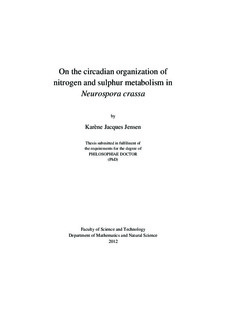| dc.description.abstract | The purpose of this thesis was to study the circadian organization of the
nitrogen and sulphur metabolism in the filamentous fungi Neurospora
crassa. Neurospora is an important model organism used in genetics
and circadian rhythm research. Its sporulation rhythm is an easily
assayed output of the circadian clock, and is generally used to study
properties of the clock. The period length of the sporulation rhythm is
temperature compensated and is approximately 22 h when Neurospora
is grown in constant darkness at 15-30°C. The sporulation rhythm in
Neurospora has been shown to be dependent on the frequency (frq)
gene, which encodes a negative acting element in the so-called
FRQ/WCC (Frequency/White Collar Complex) feedback loop. The
FRQ/WCC loop is a negative feedback in which the FRQ protein
inhibits its own transcription, and is the assumed core oscillator in the
Neurospora circadian clock.
Nitrogen is an essential nutrient in all organisms as it is an integral part
of proteins and nucleic acids. As nitrogen is often a limiting factor in
the environment, many organisms possess complex control systems for
its regulation. Nitrate is a secondary source of nitrogen in Neurospora.
Nitrate assimilation is repressed when preferable nitrogen sources such
as ammonium and glutamine are available. In the absence of preferable
nitrogen sources, activation of the nitrate assimilation pathway requires
the de-repression of the assimilatory pathway. The assimilation of
nitrate requires the enzymes nitrate reductase (NR), nitrite reductase
(NiR) and glutamine synthetase (GS). The Neurospora NR enzyme is
highly regulated, and the NR system can be considered as an
autonomous negative feedback oscillator.
Endogenous oscillations in NR activity with a period length of
approximately 24 h have been found in the Neurospora wild-type (wt)
strain, as well as in several mutants in which putative key components
VI
of the FRQ/WCC core circadian oscillator were knocked out. In order
to further study the nature of the NR activity rhythm, Neurospora
luciferase (luc) reporter strains were constructed. The luc gene from the
firefly P. pyralis had been codon-optimized for Neurospora, and was
used in the construction of reporter strains in which the promoter of the
NR structural gene, nit-3, drove the luc activity. The NR activity assay
and quantitative real-time PCR (qPCR) was used to study the
oscillations in NR activity and in nit-3 mRNA levels. The luc activity
in the nit-3-luc reporter strains was shown to oscillate. However neither
the period lengths, nor the phase of the oscillations coincided with
activity and transcript measurements obtained from qPCR/activity
experiments. Moreover, the luc reporter signal was observed in a
negative control strain in which the luc gene was expressed in the
absence of a promoter. Results indicate that nitrogen, molecular
oxygen, and metabolic intermediates from intracellular processes
appear to modulate the luc reporter activity.
The NMR protein has been implicated in the repression of NR activity.
NR activity levels were measured for the nmr-1 mutant, in which the
negative feedback of the NR system is removed. As expected, the
overall NR activity levels were elevated, but, surprisingly, an
oscillatory response with a period length of approximately 24 h was
also observed. The oscillations in NR activity levels had been shown to
be independent of frq, and it was therefore hypothesized that the
oscillations in NR activity would be abolished in frq and nmr double
knock-out (KO) strain. Because an oscillatory response in NR could in
principle still be mediated via FRQ, ΔfrqΔnmr KO strains were
constructed and the NR activity levels and nit-3 mRNA expression
measured. Surprisingly, oscillations in NR activity with period of
approximately 24 h were still observed, suggesting additional control
mechanisms other than repression by NMR.
The sporulation rhythm in a ΔfrqΔnmr KO strain was assayed at 20°,
25°, and 30°C, both under sole nitrate conditions and in the presence of
VII
ammonium. The rhythm persisted at all temperatures under nitrate
conditions, but showed poor temperature compensation. This was also
found to be the case in a frq single KO strain (frq10), and in the wt
strain. In both cases, a difference in the period length of the sporulation
rhythm in nitrate and ammonium was observed. Results therefore
indicate that nitrate may exert an effect on the sporulation rhythm of
Neurospora, and that frq appears to be important for the temperature
compensation of the sporulation rhythm.
The regulation of the Neurospora crassa sulphur circuit is similar to
that of nitrate. It is assumed that transcriptional/translational feedback
loops involving the positive acting transcription factor CYS-3 as well
as the negative acting protein SCON-2, ensure transcription of genes
needed for the uptake of sulphur in the form of sulphate. It was
therefore hypothesized that CYS-3 and SCON-2 would show periodic
oscillations on a circadian time scale. A reaction kinetic model of the
Neurospora sulphur circuit was tested, and results indicated that CYS-3
and SCON-2 protein concentrations oscillated with a period length of
approximately 22 ½ h. To further study the regulation of the sulphur
circuit, cys-3- and scon-2 luc-reporter strains were constructed.
Oscillations in luc activity were observed for both cys-3 and scon-2,
both under nitrate and ammonium conditions. qPCR showed that cys-3
mRNA was expressed in a rhythmic manner in nitrate. However, a
difference in period length was observed when qPCR and the luc
reporter data were compared. Interestingly, the oscillations observed in
the cys-3-luc reporters under ammonium conditions, had the same
phase and period length (22 h) as cys-3 levels determined by qPCR. | no_NO |
